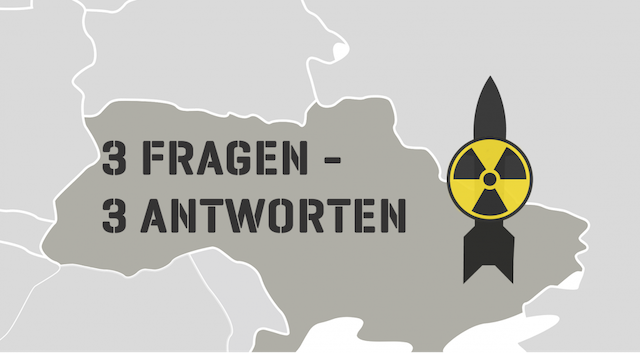Get the weekly SPARTANAT newsletter.
Your bonus: the free E-Book from SPARTANAT.

UKRAINE: 3 QUESTIONS - 3 ANSWERS, PART 24: Tactical nuclear weapons?
Oberst Jürgen Schlechter, head of the Bundesheer's ABC Defense Center, discusses "tactical nuclear weapons" in response to current questions, highlighting their usage, range of effect, and potential risks to Austria from detonations in Ukraine.
Oberst Jürgen Schlechter is the head of the Bundesheer's ABC Defense Center, which deals with nuclear, biological, and chemical threats. Here he answers current questions on the topic of "tactical nuclear weapons".

This is what the Bundesheer expert says:
What do you understand by "tactical" nuclear weapons? How and why are they used?
Tactical nuclear weapons (also called nuclear battlefield weapons) are intended to be used against enemy forces similar to conventional weapons - when conventional means prove to be too weak. Their range of effect and usually also the explosive power are significantly lower than with strategic (intercontinental) weapons - but the term "tactical" can be misunderstood in that these weapons can already cause severe destruction and release significant radioactivity.
The smallest tactical nuclear weapon has an explosive power of approximately 0.3 kT (1 kiloton - kT - is equivalent to 1,000 tons of trinitrotoluene explosive - TNT). However, the range of explosive power extends up to about 200 kT. The relatively small effective radius should allow deployment close to one's own positions. Another advantage is that this weapon can be quickly transported by truck and fired on-site by the attacking unit.
A nuclear strike with short- and medium-range weapons is not unthinkable. The likelihood of use by the Russians increases with the sustainable resistance of the Ukrainian armed forces.
How large is the effective range or damage caused by a tactical nuclear bomb?
This depends on the explosive power and the type of detonation. In a ground detonation, radioactive earth material is transported to several kilometers in height into the atmosphere, which then - depending on the prevailing wind conditions at these altitudes - falls back to the ground as so-called "radioactive fallout" and can cause widespread radiation contamination.
As an example of the immediate effects, a 10 kT nuclear weapon (comparable to the Hiroshima bomb, which was used as a "low air detonation") can be used here: the destructive primary effects such as shockwave and heat radiation would affect an area of about one to two square kilometers in the event of a ground detonation. With lesser effects, one can expect within a radius of about five kilometers.
With an air detonation, there is hardly any radioactive fallout. However, air detonations create a "nuclear electromagnetic pulse" (NEMP) that can lead to extensive destruction of electronic systems, comparable to a blackout.
Could Austria be at risk from the use of tactical nuclear bombs in Ukraine?
Austria would certainly not be affected by immediate primary effects. Only in the case of radioactive fallout from ground detonations would the spread of radioactive particles need to be assessed based on the weather conditions in the event of an incident - which the experts at the ABC Defense Center in Korneuburg can do.
One consequence to be assessed would be the so-called contamination spread by individuals or vehicles from the area where the radioactive fallout has spread: these individuals would need to undergo decontamination after checking the radiation levels. This is an activity that the Austrian Bundesheer's ABC Defense Troop is specialized in (and has also carried out after the Chernobyl nuclear power plant accident in 1986). Similarly, contamination (radiation) of food and other goods must be expected.
BUNDESHEER on the internet
UKRAINE: 3 Questions - 3 Answers
- UKRAINE: 3 QUESTIONS - 3 ANSWERS, PART 23: MARIUPOL?
- UKRAINE: 3 QUESTIONS - 3 ANSWERS, PART 22: PHOSPHOR BOMBS?
- UKRAINE: 3 QUESTIONS - 3 ANSWERS, PART 21: WAR AND LAW?
- UKRAINE: 3 QUESTIONS - 3 ANSWERS, PART 20: BIOLOGICAL WEAPONS?
- UKRAINE: 3 QUESTIONS - 3 ANSWERS, PART 19: ABC THREATS?
- UKRAINE: 3 QUESTIONS - 3 ANSWERS, PART 18: SUPPLY?
- UKRAINE: 3 QUESTIONS - 3 ANSWERS, PART 17: MISSILES AND AIR DEFENSE?
- UKRAINE: 3 QUESTIONS - 3 ANSWERS, PART 16: AIR COMBAT?
- UKRAINE: 3 QUESTIONS - 3 ANSWERS, PART 15: COMBINED ARMS COMBAT?
- UKRAINE: 3 QUESTIONS - 3 ANSWERS, PART 14: ARMORED COMBAT?
- UKRAINE: 3 QUESTIONS - 3 ANSWERS, PART 13: UNDERGROUND COMBAT?
- UKRAINE: 3 QUESTIONS - 3 ANSWERS, PART 12: CYBERWAR?
- UKRAINE: 3 QUESTIONS - 3 ANSWERS, PART 11: NEUTRALITY?
- UKRAINE: 3 QUESTIONS - 3 ANSWERS, PART 10: HOW'S IT GOING?
- UKRAINE: 3 QUESTIONS - 3 ANSWERS, PART 9: ABC DANGER?
- UKRAINE: 3 QUESTIONS - 3 ANSWERS, PART 8: BATTLE FOR THE CITIES
- UKRAINE: 3 FRAGEN - 3 ANTWORTEN, TEIL 7: LUFTKRIEG UND DROHNEN
- UKRAINE: 3 FRAGEN - 3 ANTWORTEN, TEIL 6: ATOMKRAFTWERKE UND NUKLEARE BEDROHUNG
- UKRAINE: 3 FRAGEN - 3 ANTWORTEN, TEIL 5: WELCHE WAFFEN?
- UKRAINE: 3 FRAGEN - 3 ANTWORTEN, TEIL 4: WAFFEN FÜR KIEW?
- UKRAINE: 3 FRAGEN - 3 ANTWORTEN, TEIL 3: GIBT ES WIDERSTAND?
- UKRAINE: 3 FRAGEN - 3 ANTWORTEN, TEIL 2: WELCHE FOLGEN HAT DER ANGRIFF?
SPARTANAT is the online magazine for Military News, Tactical Life, Gear & Reviews.
Send us your news: [email protected]
Ad
similar
Get the weekly SPARTANAT newsletter.
Your bonus: the free E-Book from SPARTANAT.


